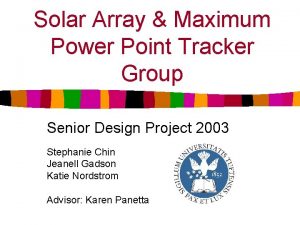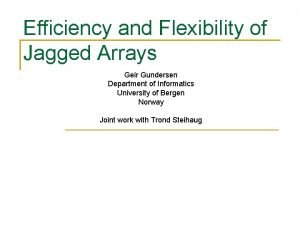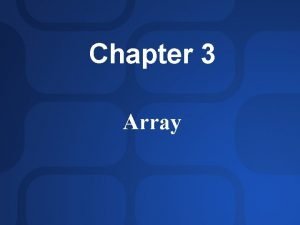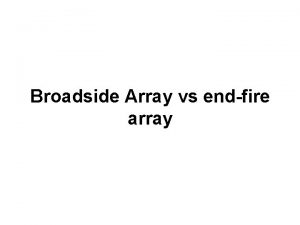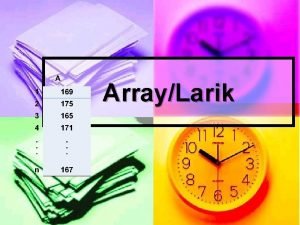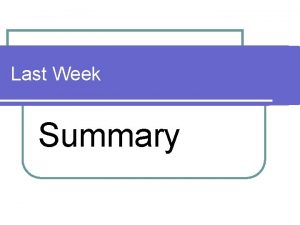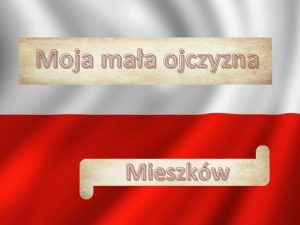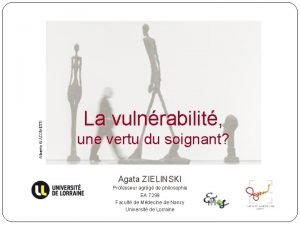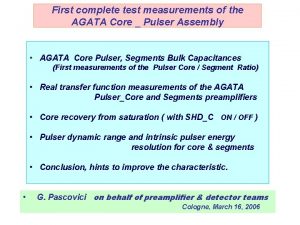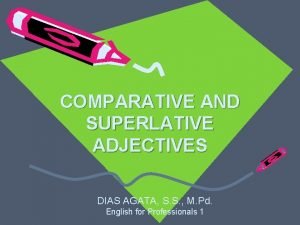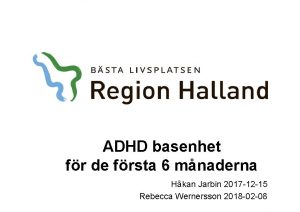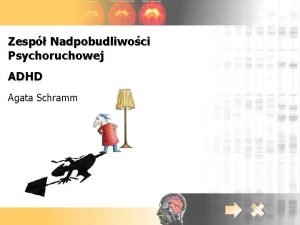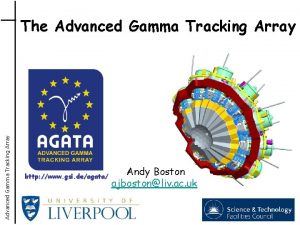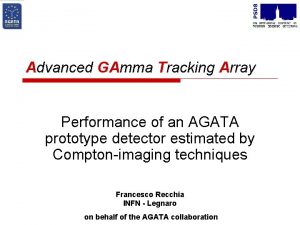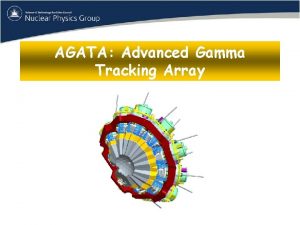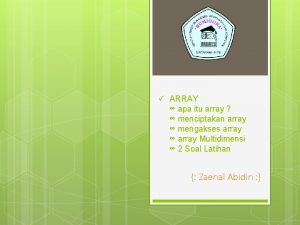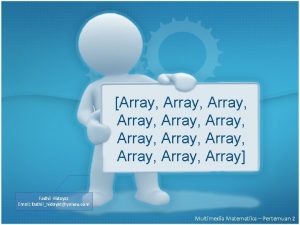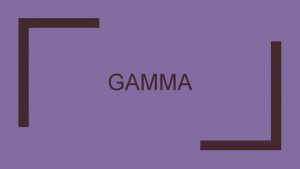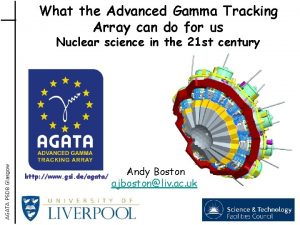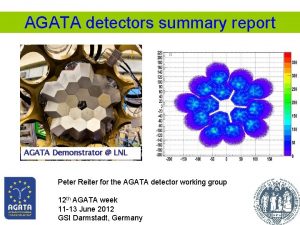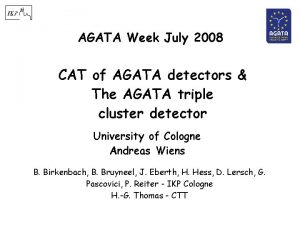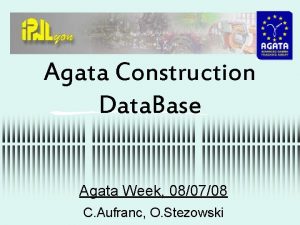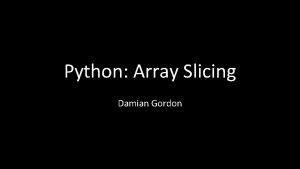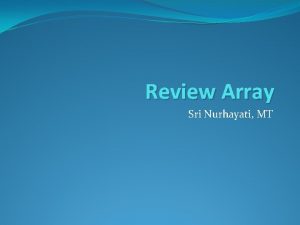AGATA Advanced Gamma Tracking Array AGATA WEEK SUMMARY




















- Slides: 20

AGATA: Advanced Gamma Tracking Array AGATA WEEK SUMMARY and STATUS MANY APOLOGIES John Simpson Nuclear Physics Group Daresbury Laboratory Presented by:

AGATA The Advanced Gamma Ray Tracking Array Ø Introduction: The AGATA project Ø Current status of the AGATA; towards the “demonstrator” Ø Exploitation of AGATA; demonstrator and beyond Next generation g-ray spectrometer based on gamma-ray tracking 4 germanium array no Compton suppression shields Versatile spectrometer with very high efficiency and excellent spectrum quality for radioactive and high intensity stable beams

AGATA (Design and characteristics) 4 -array for Nuclear Physics Experiments at European accelerators providing radioactive and stable beams Main features of AGATA Efficiency: 43% (M =1) 28% (M =30) today’s arrays ~10% (gain ~4) Peak/Total: 58% (M =1) today ~55% 5% (gain ~1000) 49% (M =30) 40% Angular Resolution: ~1º FWHM (1 Me. V, v/c=50%) ~ 6 ke. V !!! today ~40 ke. V Rates: 3 MHz (M =1) 300 k. Hz (M =30) today 1 MHz 20 k. Hz • 180 large volume 36 -fold segmented Ge crystals in 60 triple-clusters • Digital electronics and sophisticated Pulse Shape Analysis algorithms allow • Operation of Ge detectors in position sensitive mode -ray tracking

The AGATA Collaboration Memorandum of Understanding 2003 -07 Research and Development phase Bulgaria: Univ. Sofia Denmark: NBI Copenhagen Finland: Univ. Jyväskylä France: GANIL Caen, IPN Lyon, CSNSM Orsay, IPN Orsay, CEA-DSM-DAPNIA Saclay, Ire. S Strasbourg Germany: GSI Darmstadt, TU Darmstadt, Univ. zu Köln, LMU München, TU München Hungary: Debrecen Italy: INFN and Univ. Firenze, INFN and Univ. Genova, INFN Legnaro, INFN and Univ. Napoli, INFN and Univ. Padova, INFN and Univ. Milano, INFN Perugia and Univ. Camerino Poland: IFJ PAN Krakow, SINS Swierk, HIL & IEP Warsaw Romania: NIPNE & PU Bucharest Sweden: Chalmers Univ. of Technology Göteborg, Lund Univ. , Royal Institute of Technology Stockholm, Uppsala Univ. UK: Univ. Brighton, STFC Daresbury, Univ. Edinburgh, Univ. Liverpool, Univ. Manchester, Univ. Paisley, Univ. Surrey, Univ. York Turkey: Univ. of Ankara, Istanbul University

The AGATA Organisation (Many thanks to everybody) AGATA Steering Committee Chairperson: W. Korten (and EURONS) Vice Chairperson: P. J. Nolan G. de. Angelis, A. Atac, F. Azaiez, D. Balabanski, D. Bucurescu, B. Cederwall, J. Gerl, J. Jolie, R. Julin, W. Meczynski, , M. Pignanelli, G. Sletten, P. M. Walker AGATA Management Board J. Simpson (Project Manager) D. Bazzacco, G. Duchêne, P. Reiter, A. Gadea, J. Nyberg, Ch. Theisen AGATA Working Groups Detector module P. Reiter Front-end Processing D. Bazzacco Data Acquisition Ch. Theisen Design and Infrastructure G. Duchêne Ancillary detectors and integration A. Gadea Simulation and Data Analysis J. Nyberg AGATA Teams Detector and Cryostat B Bruyneel Digitisation P. Medina Data acquisition X. Grave Mechanical design J. Strachan Elec. and DAQ integration P. Bednarczyk Gamma-ray Tracking A. Lopez-Martens Preamplifiers A. Pullia Pre-processing I. Lazarus Run Control & GUI G. Maron Infrastructure P. Jones Devices for key Experiments N. Redon Physics & exp. simulation E. Farnea Detector Characterisation A. Boston Global clock and Trigger M. Bellato R & D on gamma Detectors D. Curien Impact on performance M. Palacz Detector data base K. Hauschild Mechanical Integration J. Valiente Dobon Data analysis O. Stezowski PSA R. Gernhaeuser/ P. Desesquelles

The First Step: The AGATA Demonstrator Objective of the final R&D phase 2003 -2008 1 symmetric triple-cluster 5 asymmetric triple-clusters 36 -fold segmented crystals 540 segments 555 digital-channels Eff. 3 – 8 % @ M = 1 Eff. 2 – 4 % @ M = 30 Full EDAQ with on line PSA and -ray tracking In beam Commissioning Technical proposal for full array Cost ~ 6 M € Capital

AGATA Detectors Symmetric detectors – 3 delivered Asymmetric detectors – 17 ordered (6 accepted, 4 in test, 7 in 2007/8) Preamplifiers available Hexaconical Ge crystals 90 mm long 80 mm max diameter 36 segments Al encapsulation 0. 6 mm spacing 0. 8 mm thickness 37 vacuum feedthroughs – Core (Cologne); Segment (Ganil & Milano) Test cryostats for characterisation – 5 delivered Triple cryostats – 4 (soon 5) ordered – 1 st being assembled November 2007

AGATA triple-detector module 3 encapsulated Ge crystals in one cryostat 111 preamplifiers with cold FET ~230 vacuum feedthroughs LN 2 dewar, 3 litre, cooling power ~8 watts First prototype summer 2005

AGATA triple-detector module Plans for 2007: First asymmetric triple module being assembled now Source and possibly in-beam tests using “standard” digital electronics

AGATA Design and Construction 180 geometry defined Conceptual design of 180 array done Specifications of infrastructure parts done Design of AGATA demonstrator for LNL final stages Flanges manufacture started Assembly in LNL, 2007

Characteristation and Scanning Comparison of real and calculated pulse shapes. Validate codes. Coincidence scan for 3 D position determination Two symmetric capsules scanned in Liverpool Commissioning of further 374 ke. V 662 ke. V 288 ke. V scanning systems at Orsay and GSI Scan of an asymmetric capsule in Liverpool: A PRIORITY Scan of the 3 rd symmetric capsule

Pulse-Shape Analysis: current status Results from the analysis of an in-beam test with the first triple module, e. g. Doppler correction of gamma-rays using PSA results d(48 Ti, p)49 Ti, v/c ~6. 5% Results obtained with Grid Search PSA algorithm (R. Venturelli et al. ) Position resolution ~4. 4 mm Many different methods are under development Implementation decision?

AGATA Digitiser Module 36+1 channels, 100 Mh. Z, 14 bits (Strasbourg - Daresbury – Liverpool) • Mounted close to the Detector 5 -10 m • Power Dissipation around 400 W • Water Cooling required • Testing in Liverpool (December 2006) • Production in progress (for 18 modules) Prototype Segment Board (2 boards per crystal) First production digitizer at Daresbury

Pre-processing modules (E, T, hits, …) ATCA standard : “full mesh” communication with Gbit Ethernet or PCIexpress switches 1 ATCA crate for 2 clusters (6 Ge crystals, 222 channels) • Prototypes tested in 2006 • Core digitizer to core mezzanine and carrier communication errors • Redesign of carrier (from Nov 06) • Redesign of mezzanines (from Dec 06) • New cards under test • Good results so far

Timescales for the AGATA demonstrator Six years research and development phase of AGATA Start January 2003 ― End December 2008 • First three symmetric Ge crystals delivered in 2004 • First triple module tested in-beam in summer 2005 • Two symmetric crystals scanned for PSA by end 2006 • First electronics prototypes delivered in summer 2006 • Five asymmetric Ge crystals delivered by end 2006 • First scan of asymmetric crystals planned autumn 2007 • First AGATA triple module ready by autumn 2007 • Second generation electronics prototypes by autumn 2007 • Commissioning of first full electronics chain in spring 2008 • Commissioning of sub array at Legnaro from autumn 2008

Status and Evolution First physics campaign at LNL in 2009 Next campaigns at GANIL then GSI Mo. U for AGATA construction from 2008 Aim 1 in possible in ~2011 Rate of construction depends on production capability and financing Stages of physics exploitation, facility development

More Information AGATA web page http: //www. gsi. de/agata/ Talks from last AGATA week ORSAY January 2007 http: //www. csnsm. in 2 p 3. fr/groupes/strucnuc/AGATAWEEK/agataweek. html

The Management

Thanks

 Photovoltaic array maximum power point tracking array
Photovoltaic array maximum power point tracking array Delacons
Delacons Week by week plans for documenting children's development
Week by week plans for documenting children's development Lga vs pga
Lga vs pga Deklarasi array x adalah
Deklarasi array x adalah Jagged array
Jagged array Associative array vs indexed array
Associative array vs indexed array Comparison between broadside array and endfire array
Comparison between broadside array and endfire array Menginisialisasi artinya
Menginisialisasi artinya Suatu array dikatakan upper triangular jika
Suatu array dikatakan upper triangular jika Python 2 dimensional array
Python 2 dimensional array Last week summary
Last week summary Agata kałużna mieszków
Agata kałużna mieszków Agata zielinski
Agata zielinski Agata miklis
Agata miklis Pozostali bohaterowie karolci
Pozostali bohaterowie karolci Agata core
Agata core Superlative good
Superlative good Snap-iv bedömning
Snap-iv bedömning Agata miklis
Agata miklis Agata miklis opole
Agata miklis opole
